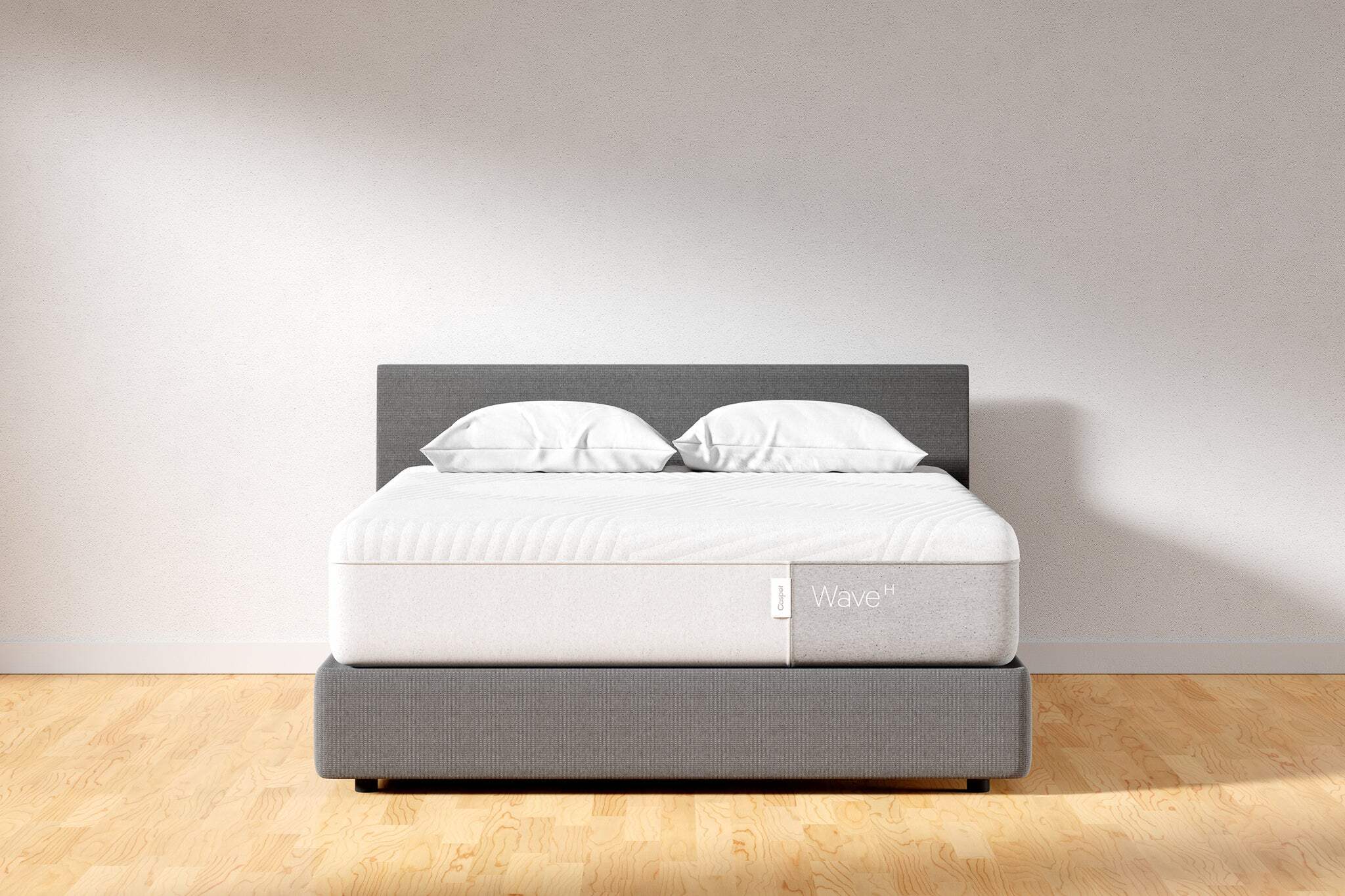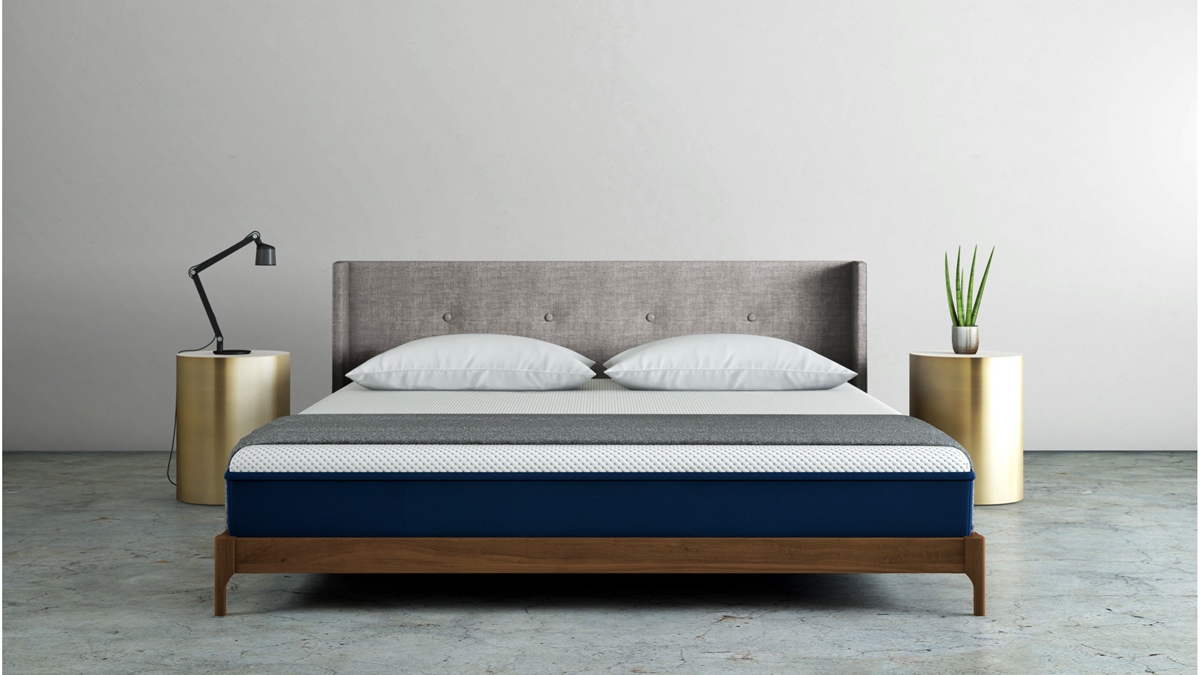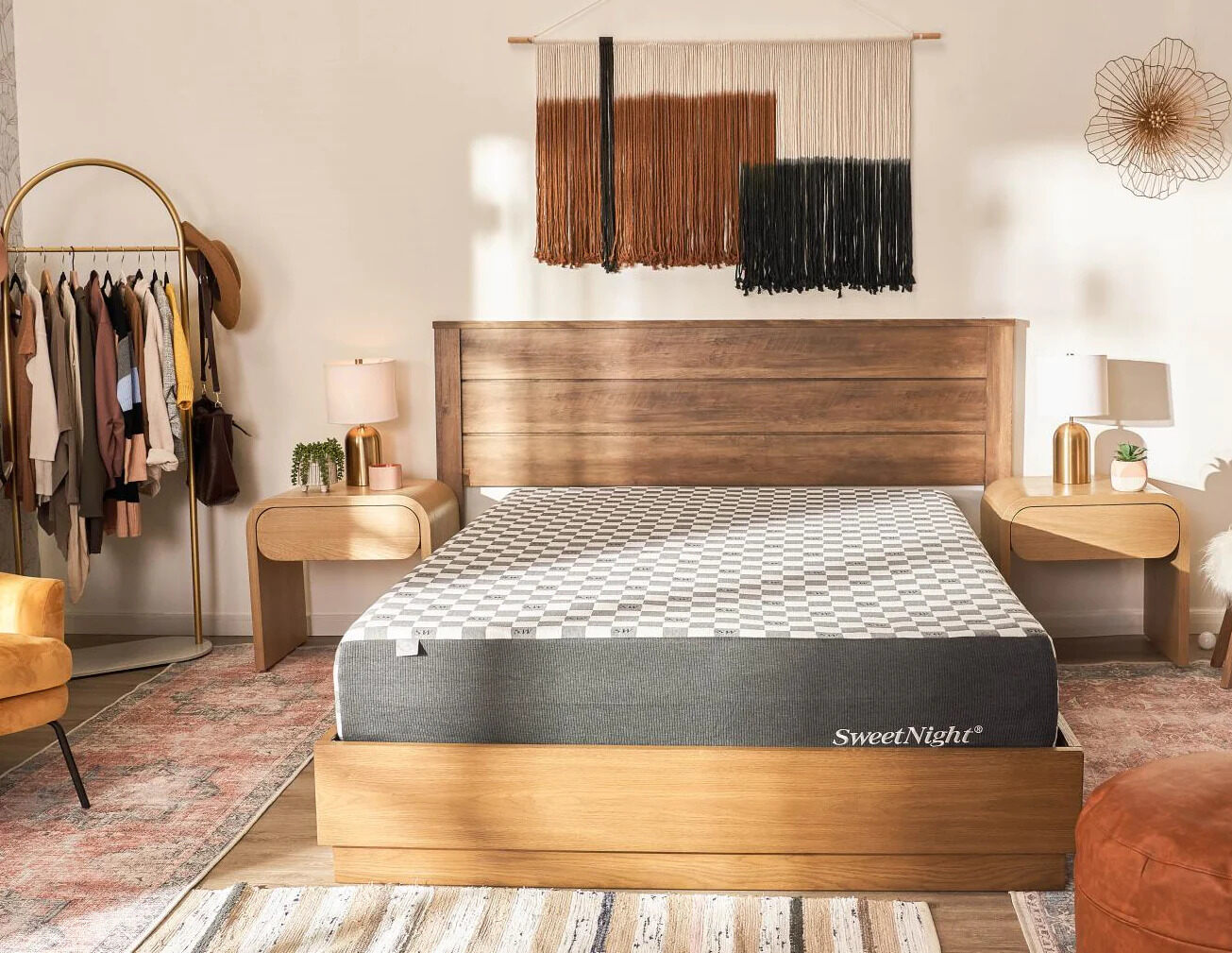Home>Furniture>Bedroom Furniture>How Do I Know When I Need A New Mattress


Bedroom Furniture
How Do I Know When I Need A New Mattress
Modified: October 20, 2024
"Discover the signs that indicate it's time to replace your mattress. Upgrade your bedroom furniture for a better night's sleep with our expert advice."
(Many of the links in this article redirect to a specific reviewed product. Your purchase of these products through affiliate links helps to generate commission for Storables.com, at no extra cost. Learn more)
Introduction
Choosing the right mattress is essential for getting a good night’s sleep and ensuring optimal comfort and support. But how do you know when it’s time to replace your current mattress with a new one? In this article, we will explore the signs that indicate you may need a new mattress and provide helpful tips for selecting the perfect one to suit your needs.
Mattresses are designed to provide a comfortable and supportive sleep surface, but over time they can become worn out, lose their shape, and accumulate allergens. Sleeping on an old and worn-out mattress can lead to a host of issues like chronic pain, restless nights, and difficulty falling asleep. It’s crucial to pay attention to any signs that your mattress is past its prime and be proactive in making a change.
While the lifespan of a mattress varies depending on its quality and usage, a general rule of thumb is to consider replacing it every 7 to 10 years. Of course, individual factors such as personal comfort preferences, changes in body weight, and lifestyle can also influence the need for a new mattress.
In the following sections, we will examine the key indicators that signal it’s time to say goodbye to your current mattress and invest in a new one. By recognizing these signs, you can take the necessary steps to improve your sleep quality and overall well-being. Let’s dive in!
Key Takeaways:
- Invest in a high-quality mattress that aligns with your comfort preferences and provides adequate support, promoting better sleep quality and overall well-being.
- Consider factors such as mattress type, firmness level, and size to find the perfect mattress that caters to your unique sleep needs and enhances your sleep experience.
Read more: How Do You Know When You Need A New Roof
Signs that you need a new mattress
1. Chronic pain or discomfort: If you often wake up with backaches, neck pain, or muscle stiffness, it could be a sign that your mattress is no longer providing adequate support. Over time, the materials in a mattress can break down, leading to sagging or unevenness. This can result in improper spinal alignment, causing discomfort and pain.
2. Visible wear and tear: Take a close look at your mattress. Are there visible signs of wear and tear, such as frayed edges, rips, or coils poking through? These are indications that your mattress has reached the end of its lifespan and needs to be replaced.
3. Lumps, sagging, or unevenness: As mentioned earlier, wear and tear can lead to lumpy and sagging areas on your mattress. If you can feel noticeable indentations or unevenness when you lie down, it’s a clear sign that the mattress is no longer providing the necessary support for your body.
4. Allergies or respiratory issues: Over time, mattresses can accumulate allergens such as dust mites, mold, and mildew. If you find yourself waking up with allergy symptoms like sneezing, itchy eyes, or congestion, it may be time to replace your mattress and create a healthier sleep environment.
5. Sleeping difficulties or restless nights: Are you tossing and turning during the night, struggling to find a comfortable position? An old and worn-out mattress can interfere with your sleep quality and leave you feeling tired and restless in the morning. If your sleep has been consistently disrupted, it’s a good indication that you need a new mattress.
6. Changes in body weight or lifestyle: Significant changes in body weight, such as weight gain or weight loss, can impact the level of support needed from a mattress. Additionally, if you’ve undergone a major lifestyle change, such as starting an exercise routine or experiencing a pregnancy, you may require a different type of mattress to accommodate your new needs.
7. Age of the mattress: While individual mattress lifespans vary, if your mattress is over 7 to 10 years old, it’s recommended to evaluate its condition and consider a replacement. Even if your mattress appears to be in decent shape, the internal components may have deteriorated, compromising its comfort and support.
By being aware of these signs, you can assess whether it’s time to invest in a new mattress. Remember, a quality mattress is an investment in your health and well-being, promoting better sleep and ultimately enhancing your overall quality of life.
Chronic pain or discomfort
One of the most telling signs that you may need a new mattress is if you experience chronic pain or discomfort, particularly in your back, neck, or joints. Your mattress plays a crucial role in providing proper support for your body while you sleep. Over time, however, mattresses can become worn out and lose their ability to properly support your body”s natural alignment.
When a mattress starts to deteriorate, it can lead to sagging or unevenness, which can cause the spine to be misaligned during sleep. This misalignment can put stress on certain areas of the body and result in pain and discomfort. If you consistently wake up with a sore back or neck, or if you feel stiff and achy in the morning, it’s a strong indication that your mattress is no longer providing the necessary support.
Furthermore, an old mattress may not be able to properly cushion pressure points, such as hips and shoulders. This can result in increased pressure in those areas, leading to pain and discomfort. If you notice that you frequently wake up with pain in specific areas of your body, it’s a sign that your mattress is no longer able to distribute pressure evenly.
It’s important to address these issues as they can disrupt your sleep quality and impact your daily life. Poor sleep can affect your mood, productivity, and overall well-being. If you find yourself in chronic pain or discomfort, it’s time to consider investing in a new mattress that can provide the necessary support and alleviate these issues.
When shopping for a new mattress to address chronic pain or discomfort, consider opting for one that offers good back support and pressure relief. Look for mattresses with firmness levels that are appropriate for your needs. While a firmer mattress can provide more support, it’s important to find the right balance that ensures both support and comfort for your body.
Additionally, consider mattresses that have specialized features for pain relief, such as memory foam or latex mattresses that conform to your body’s contours and provide targeted support where needed. These materials can help alleviate pressure points and promote proper spinal alignment, ultimately reducing pain and discomfort.
Remember, sleep is essential for your physical and mental well-being. If chronic pain or discomfort is interrupting your sleep, it’s time to prioritize your health and invest in a new mattress that can provide the support and comfort you need for a restful night’s sleep.
Visible wear and tear
Another clear sign that you may need a new mattress is the presence of visible wear and tear. Over time, mattresses can become worn out and show signs of aging. These signs can include frayed edges, rips or tears in the fabric, or even coils poking through the mattress surface.
Visible wear and tear not only affect the aesthetics of your mattress but can also impact its functionality and durability. A mattress with damaged or worn-out components may no longer provide the necessary support and comfort for a good night’s sleep.
Inspect your mattress closely, paying attention to the edges, stitching, and surface. If you notice any signs of damage or deterioration, it’s a clear indication that your mattress is no longer in optimal condition. It’s important to replace it to ensure proper support and prevent further damage to your body and mattress.
When considering a replacement mattress, look for one made with high-quality materials and strong construction. A durable mattress is more likely to withstand wear and tear over an extended period. Reinforced edges can also contribute to the longevity and stability of the mattress.
Additionally, maintaining a clean and well-protected mattress can help prolong its lifespan and minimize wear and tear. Using a mattress protector can provide a barrier against spills, stains, and allergens, preventing damage and preserving the mattress’s integrity.
Remember that a mattress with visible wear and tear not only affects the aesthetic appeal of your bedroom but also compromises your sleep quality and comfort. Investing in a new mattress will ensure that you have a fresh and intact sleep surface that offers the support and comfort your body needs for a rejuvenating sleep experience.
Lumps, sagging, or unevenness
One of the telltale signs that your mattress is past its prime is the presence of lumps, sagging, or unevenness. As mattresses age, the materials inside can degrade, leading to a loss of support and structural integrity. This can result in the formation of lumps and indentations in the mattress surface, making it uncomfortable to sleep on.
One common issue is when the area where you usually sleep starts to sag, creating a noticeable indentation. This can occur due to the compression of the mattress material over time. When a mattress sags, it can cause an uneven sleeping surface, leading to poor spinal alignment and potential discomfort.
Aside from sagging, lumps can also develop in a mattress. These uneven areas can be caused by the shifting or bunching of the internal components, such as springs or foam layers. Lumps can create pressure points, causing discomfort and disrupting your sleep.
Sleeping on a mattress with lumps, sagging, or unevenness can put stress on your body’s pressure points, leading to pain and discomfort. It can also affect the quality of your sleep, as finding a comfortable position becomes challenging. If you find yourself constantly adjusting and shifting positions to find a more even spot on your mattress, it’s a sure sign that a replacement is necessary.
When shopping for a new mattress, consider opt for one that is designed to resist sagging and maintain its shape over time. Look for mattresses with high-quality materials that offer durability and resilience. Memory foam mattresses, for example, can be a good choice as they conform to your body while providing consistent support.
It’s also worth considering mattresses with reinforced edges. These edges help maintain the mattress’s shape, preventing excessive sagging and ensuring consistent support across the entire surface.
Remember, a lumpy, sagging, or uneven mattress not only affects your comfort but also impacts the quality of your sleep. By investing in a new mattress that provides even support and a consistent sleep surface, you can enjoy a more restful and rejuvenating sleep experience.
Allergies or respiratory issues
If you find yourself waking up with allergy symptoms or experiencing respiratory issues, it could be a sign that your mattress is contributing to the problem. Over time, mattresses can accumulate allergens such as dust mites, mold, and mildew, which can trigger allergic reactions and respiratory problems.
Dust mites, in particular, are microscopic organisms that thrive in warm and humid environments. They feed on dead skin cells and can be found in bedding, including mattresses. These tiny pests can cause allergies and asthma symptoms, including sneezing, coughing, itchy eyes, and congestion. If you notice an increase in these symptoms upon waking, it may be time to replace your mattress.
Mold and mildew are another concern when it comes to mattresses. These fungi can grow in moist environments, and if your mattress has been exposed to moisture or excessive humidity, it could result in the development of mold and mildew. Breathing in mold spores can lead to respiratory issues and allergic reactions.
Replacing your old mattress with a new one can eliminate the accumulation of allergens and improve your indoor air quality. Look for mattresses with allergy-friendly features, such as hypoallergenic materials that resist dust mites, mold, and mildew. Some mattresses have covers or fabrics treated with anti-microbial properties, further reducing the risk of allergen buildup.
To prevent allergens from accumulating in your mattress, it’s essential to practice good mattress hygiene. Regularly vacuum your mattress to remove dust and allergens, and consider using a mattress protector or encasement to create a physical barrier against dust mites and other irritants.
By replacing your mattress and taking steps to reduce allergens, you can create a healthier sleep environment and minimize the risk of allergy symptoms and respiratory issues. Good quality sleep is essential for overall well-being, so ensuring a clean and allergen-free mattress is an important step toward better sleep hygiene.
Sleeping difficulties or restless nights
If you find yourself tossing and turning throughout the night or struggling to find a comfortable position, it could be a sign that your mattress is no longer providing the necessary support and comfort for a good night’s sleep. Difficulty sleeping can be frustrating and can lead to feelings of restlessness and fatigue during the day.
An old or worn-out mattress may have lost its ability to cushion and support your body properly. It may develop uneven spots, sagging areas, or lumps that can disrupt your sleep and prevent you from finding a comfortable position. As a result, you may find yourself constantly readjusting, searching for a spot that offers better support or a more even sleep surface.
Furthermore, an uncomfortable mattress can lead to increased pressure on certain areas of your body, such as the hips, shoulders, and lower back. This pressure can cause discomfort and pain, making it challenging to find a position that allows you to relax and drift off into deep sleep.
When experiencing sleeping difficulties or restless nights, it’s worth considering investing in a new mattress that addresses these issues. Look for a mattress that offers the right level of firmness or softness to suit your personal preferences and provides adequate support for your body’s alignment.
Memory foam mattresses, for example, can offer excellent contouring and pressure relief by conforming to your body’s shape. They can help alleviate pressure points and promote a more restful sleep. On the other hand, if you prefer a more traditional feel, an innerspring mattress with individually wrapped coils can offer targeted support and motion isolation.
Additionally, consider your personal sleep habits and preferences. If you sleep with a partner, look for a mattress that minimizes motion transfer, allowing both of you to enjoy uninterrupted sleep. If you tend to sleep hot, consider a mattress with cooling features like gel-infused foam or breathable materials to prevent overheating and night sweats.
By investing in a new mattress that caters to your specific needs and promotes better sleep, you can improve your sleep quality, wake up feeling refreshed, and enjoy more restful nights.
Changes in body weight or lifestyle
If you’ve experienced significant changes in body weight or lifestyle, it can impact the suitability of your current mattress. Your weight distribution plays a crucial role in determining the level of support and comfort you need from a mattress. When your body weight changes, your mattress may no longer be able to provide the proper support and alignment.
Weight gain, for example, can put additional pressure on a mattress, causing it to sag and lose its shape. This can lead to discomfort, lack of support, and restless nights. On the other hand, if you’ve lost a significant amount of weight, your mattress may feel too firm and lack the necessary cushioning.
Lifestyle changes can also affect your mattress needs. Starting a new exercise routine or experiencing pregnancy, for instance, can cause temporary or long-term changes in your body that require a different level of support and comfort. In these situations, it may be necessary to reassess your mattress and determine if it’s still suitable for your needs.
When considering a new mattress to accommodate changes in body weight or lifestyle, it’s important to find one that provides the right balance of support and comfort. Look for a mattress with good responsiveness that can adapt to the unique contours and movements of your body.
Memory foam mattresses can be a great option as they conform to your body shape, providing personalized support and pressure relief. This can be particularly beneficial for individuals with varying weight distribution or specific pressure points. Additionally, adjustable mattresses that allow you to change the firmness or elevation can offer customized support to adapt to changing body needs.
It’s also worth considering mattresses with good edge support, especially if you tend to sit or sleep near the edges. This ensures that you have stability and support across the entire mattress surface, no matter your body weight or position.
By acknowledging changes in body weight or lifestyle and investing in a mattress that caters to these changes, you can ensure that you’re getting the right level of support and comfort needed for a restful and rejuvenating sleep experience.
Age of the mattress
The age of your mattress is an important factor to consider when determining if it’s time for a replacement. While the lifespan of a mattress can vary depending on its quality, usage, and maintenance, a general guideline is to consider replacing it every 7 to 10 years.
Over time, the materials inside a mattress can wear out, leading to reduced support and comfort. The foam may lose its elasticity, the coils may become weak and saggy, and the overall integrity of the mattress may deteriorate. These changes can significantly affect your sleep experience and overall well-being.
Even if your mattress may still appear to be in good condition, it’s important to consider the age of the mattress and assess how it’s been performing. Pay attention to any changes in how you feel when you wake up, such as increased stiffness or discomfort. If you notice a decline in sleep quality or recurring issues, it may be time to replace your mattress.
It’s essential to note that the lifespan of a mattress can be influenced by factors such as the quality of the materials and construction, usage patterns, and body weight. Heavier individuals may experience more wear and tear on their mattresses and may need to replace them more frequently.
By replacing an older mattress, you can benefit from the advancements in mattress technology and improved sleep surfaces. Newer mattresses often incorporate innovative materials and design features that can enhance support, pressure relief, and overall comfort.
When shopping for a new mattress based on age considerations, prioritize factors such as durability and longevity. Look for mattresses with longer warranties as an indicator of their expected lifespan. Consider the reputation and reviews of the brand and model to ensure you invest in a high-quality product that can withstand years of use.
Ultimately, the age of your mattress should be taken into account along with other signs of wear and tear, discomfort, and changes in sleep quality. By being proactive in replacing your mattress when it’s nearing the end of its recommended lifespan, you can ensure a comfortable and supportive sleep environment for years to come.
Read more: How Do I Know If I Need Foundation Repair
Factors to consider when buying a new mattress
When it comes to buying a new mattress, there are several factors to consider to ensure that you choose the right one for your needs. A mattress plays a crucial role in your sleep quality, comfort, and overall well-being, so it’s essential to make an informed decision. Here are some key factors to keep in mind when shopping for a new mattress:
- Mattress type: There are various types of mattresses available, including innerspring, memory foam, latex, and hybrid. Each type has its own unique feel and characteristics, so it’s important to choose one that aligns with your preferences and needs.
- Firmness level: The firmness of a mattress is a personal preference and can vary based on factors such as body weight and sleep position. Whether you prefer a plush, medium, or firm feel, selecting the right firmness level is crucial for optimal comfort and support.
- Size and dimensions: Consider the size of your bedroom and the space available for the mattress. Common sizes include twin, full, queen, and king. Ensure that the mattress dimensions align with your bed frame and allow for comfortable movement during sleep.
- Motion transfer: If you sleep with a partner, a mattress with good motion isolation can minimize disturbances caused by their movements throughout the night. Look for mattresses that absorb motion and prevent it from transferring across the bed.
- Support and pressure relief: A mattress should provide adequate support to maintain proper spinal alignment and relieve pressure on sensitive areas. Look for mattresses with features that promote support and pressure point relief, such as targeted support zones or responsive foam layers.
- Durability and warranty: Consider the durability of the mattress and the warranty provided by the manufacturer. A longer warranty period typically indicates confidence in the mattress’s quality and longevity.
- Budget and price range: Set a budget before mattress shopping and consider your price range. Keep in mind that a mattress is an investment in your sleep quality, so prioritize quality over price alone.
- Personal preferences and sleeping position: Take into account your personal preferences, such as whether you prefer a cooler or warmer mattress, or if you have specific sleep needs due to back pain or other conditions. Different mattresses cater to different sleeping positions, so choose one that suits your sleeping style.
By considering these factors, you can narrow down your options and choose a mattress that best suits your individual needs. Don’t be afraid to spend some time testing out different mattresses in stores or reading reviews online. Remember, a good mattress is an investment in your sleep quality and overall well-being, so choose wisely.
If you wake up with aches and pains, notice sagging or lumps in your mattress, or have trouble getting comfortable, it may be time for a new mattress. Aim to replace your mattress every 7-10 years for optimal comfort and support.
Mattress type
When shopping for a new mattress, one of the first decisions you’ll need to make is the type of mattress that suits your preferences and needs. There are several types of mattresses available in the market, each offering a unique feel and set of features. Understanding the different mattress types can help you make an informed choice. Here are some common mattress types to consider:
- Innerspring: Innerspring mattresses are the most traditional and widely used type. They consist of coils or springs that provide support and structure. The coils can vary in thickness and shape, with options like bonnell, offset, or pocketed coils. Innerspring mattresses often offer good breathability and can provide a bouncy and supportive feel.
- Memory Foam: Memory foam mattresses have gained popularity for their contouring and pressure-relieving properties. These mattresses are made of viscoelastic foam that molds to your body shape and responds to heat and pressure. Memory foam mattresses can offer excellent support, reduce motion transfer, and relieve pressure points for a more comfortable sleep experience.
- Latex: Latex mattresses are constructed from natural or synthetic latex. They are known for their responsiveness, durability, and natural breathability. Latex offers a bouncy and buoyant feel, with a good balance of support and comfort. They are also hypoallergenic and resistant to dust mites and mold, making them a suitable choice for those with allergies.
- Hybrid: Hybrid mattresses combine the benefits of innerspring and foam mattresses. They typically feature a layer of pocketed coils for support and comfort layers such as memory foam or latex. Hybrid mattresses aim to provide the best of both worlds — the support of coils and the pressure relief of foam. These mattresses are a popular choice for individuals seeking a balance between support and contouring.
- Pillow-top: Pillow-top mattresses have an additional layer of padding on top for extra softness and comfort. The pillow-top layer can be made of different materials such as memory foam, latex, or fibers. These mattresses offer a plush and luxurious feel, making them a good choice for individuals who prefer a softer sleep surface.
When choosing a mattress type, consider your specific needs, preferences, and sleep style. If you enjoy a bouncier feel and prefer a traditional mattress, an innerspring mattress may be a suitable choice. For individuals who require pressure relief or have specific comfort requirements, memory foam or latex mattresses can be a great option. Hybrids provide a combination of support and contouring, while pillow-top mattresses offer an extra layer of plushness.
It’s worth mentioning that there are differences in the quality and performance of mattresses within each type. Take the time to test out various mattresses, consider reputable brands, and read customer reviews to find a mattress type that aligns with your sleep preferences and provides the comfort and support you need for a restful night’s sleep.
Firmness level
The firmness level of a mattress refers to how soft or firm it feels when you lie down. It plays a crucial role in providing the right balance of support and comfort based on your personal preferences and needs. Understanding the different firmness levels can help you choose a mattress that suits your sleeping style. Here are some common firmness levels to consider when buying a new mattress:
- Soft: Soft mattresses offer a plush and cushion-like feel. They contour closely to your body and provide a sinking-in sensation. Soft mattresses can be beneficial for side sleepers who require pressure relief on their hips and shoulders. They can also be suitable for individuals with lighter body weight or those who prefer a more “hugging” sensation.
- Medium-Soft: Medium-soft mattresses provide a balance between softness and support. They have a slightly firmer feel compared to soft mattresses, offering gentle contouring and moderate sinkage. Medium-soft mattresses are ideal for combination sleepers who switch positions during the night. They provide a good level of pressure relief while still offering support for back and stomach sleepers.
- Medium: Medium firmness is a popular choice as it caters to a wide range of sleepers. It offers a balance between comfort and support, providing enough contouring to relieve pressure points while maintaining proper spinal alignment. Medium mattresses are suitable for most sleep positions, accommodating a variety of body types and weights.
- Medium-Firm: Medium-firm mattresses offer a slightly firmer feel with less sinkage. They provide more support and are ideal for back and stomach sleepers who need extra spinal support. Medium-firm mattresses can also be beneficial for individuals with back pain or those who prefer a more supportive feel.
- Firm: Firm mattresses have minimal sinkage and provide a solid, supportive surface. They offer less contouring and more push-back against your body. Firm mattresses are preferred by stomach sleepers or individuals who require optimal spinal alignment. They can also be suitable for heavier individuals who need extra support to prevent excessive sinking.
It’s important to note that the ideal firmness level can vary from person to person based on factors such as body weight, sleep position, and personal preference. It’s advisable to try out different firmness levels to determine what feels most comfortable for you. Keep in mind that the firmness level can impact the support, pressure relief, and overall comfort of the mattress.
If you’re unsure about which firmness level to choose, consider opting for a mattress with adjustable firmness or one that offers a “universal” feel, which aims to cater to a wide range of sleepers. Additionally, take advantage of generous return policies or sleep trials offered by mattress retailers to ensure you can exchange or return the mattress if it doesn’t provide the desired level of comfort and support.
Remember, selecting the right firmness level is essential for achieving a restful and comfortable sleep experience. Take the time to find the right balance between support and comfort, considering your specific sleep needs and preferences.
Size and dimensions
Choosing the right size and dimensions for your mattress is crucial to ensure a comfortable sleep experience that fits your needs and space. Consider the following factors when determining the size and dimensions of your new mattress:
- Twin: Twin mattresses are 38 inches wide and 75 inches long. They are suitable for children, teenagers, or individuals with limited space in their room. Twin XL mattresses are slightly longer, measuring 80 inches in length, and are a popular choice for taller individuals.
- Full: Full mattresses, also known as double mattresses, are 54 inches wide and 75 inches long. They offer more width than a twin mattress and can be a good choice for single adults or individuals who prefer more sleep surface area. However, for couples, a full-size mattress may be too narrow for comfortable sharing.
- Queen: Queen mattresses are the most popular size for couples. They measure 60 inches wide and 80 inches long, offering more room for two people to sleep comfortably. Queen mattresses are also suitable for single individuals who desire extra space for movement during sleep.
- King: King mattresses are 76 inches wide and 80 inches long, providing ample space for couples to spread out and sleep without disturbing each other. King mattresses are ideal for individuals who prefer a larger sleep surface or have pets or children sharing the bed. They also come in a split king option, which allows for independent customization on each side of the mattress.
- California King: California King mattresses are longer and narrower than traditional king mattresses. They measure 72 inches wide and 84 inches long, providing extra legroom for taller individuals. California King mattresses are a great option for individuals who need extra length or prefer a more elongated sleeping surface.
When choosing the size and dimensions of your mattress, consider the space available in your bedroom. Ensure that there is enough room for the mattress to fit comfortably, allowing for easy movement around the bed. Take into account other bedroom furniture and any obstructions, such as doors or windows, that may affect placement and access to the mattress.
Additionally, consider your sleep preferences and whether you share the bed with a partner, children, or pets. It’s important to have enough room to sleep comfortably and avoid feeling cramped or restricted. Couples may find a queen or king size more suitable, while individuals or smaller bedrooms may opt for a twin or full size.
Remember to measure your bedroom and consider any specific requirements or preferences before making a decision on the size and dimensions of your new mattress. It’s worth noting that bedding and accessories, such as bed frames, sheets, and duvets, may vary in size based on the mattress dimensions, so factor in these considerations as well.
By choosing the right size and dimensions, you can ensure a comfortable and well-fitted mattress that meets your sleep needs and maximizes the space in your bedroom.
Read more: How Do I Know If I Need A C-Wire Adapter
Motion transfer
Motion transfer refers to how much movement is transferred from one side of the mattress to the other. This factor is particularly important for individuals who share their bed with a partner or a pet. If one person’s movements disturb the other, it can disrupt sleep and lead to a less restful experience. Here are some considerations regarding motion transfer when choosing a new mattress:
- Innerspring mattresses: Innerspring mattresses traditionally have higher motion transfer because the coils are interconnected. When one person moves, the entire mattress can bounce, causing disturbances for the other person. However, some modern innerspring mattresses now come with individually pocketed coils, which can help reduce motion transfer to a certain extent.
- Memory foam mattresses: Memory foam mattresses are known for their excellent ability to isolate motion. The dense and viscoelastic nature of memory foam absorbs movement and prevents it from being felt on the other side of the mattress. If you or your partner toss and turn during sleep, a memory foam mattress can minimize the impact of those movements, allowing for a more peaceful sleep environment.
- Latex mattresses: Latex mattresses also offer good motion isolation due to their natural elasticity and responsiveness. They absorb and dampen movements, making them suitable for couples who want to minimize the disturbance caused by each other’s movements during sleep.
- Hybrid mattresses: Hybrid mattresses combine the features of innerspring and foam mattresses. The motion transfer in hybrid mattresses can vary depending on the specific design and materials used. If motion transfer is a concern, look for hybrid mattresses with a substantial layer of memory foam or latex, as these materials are effective at reducing motion transfer.
To determine the motion transfer capabilities of a mattress, consider reading customer reviews or trying out the mattress in-store if possible. Ask the retailer or manufacturer for information about the specific construction and materials used in the mattress, as this can contribute to its motion isolation properties.
If you or your partner are particularly sensitive to motion transfer, consider mattresses with features designed to minimize disturbances. Look for mattresses that advertise excellent motion isolation or those specifically marketed as being “motion-free” or “motion-dampening.”
Remember, the level of motion transfer that is acceptable can depend on your personal preference and sensitivity. What may feel disruptive to one person might not be an issue for another. Communication with your partner and understanding each other’s sleep needs can help in choosing a mattress that minimizes disruptions during sleep.
By selecting a mattress with good motion isolation, you can enjoy a more peaceful and restful sleep, undisturbed by the movements of your partner or pets sharing the bed.
Support and pressure relief
When looking for a new mattress, it’s important to consider both support and pressure relief. A mattress that offers proper support and effective pressure relief can help maintain proper spinal alignment and alleviate discomfort or pain. Here are some factors to consider regarding support and pressure relief:
- Surface firmness: The firmness level of a mattress plays a significant role in determining its support and pressure-relieving capabilities. The mattress should be firm enough to provide support and maintain proper spinal alignment, but also soft enough to alleviate pressure on sensitive areas.
- Supportive layers: A mattress with a supportive base layer is essential for maintaining proper spinal alignment. Whether it’s the core in an innerspring mattress or the dense foam layer in a memory foam mattress, having a sturdy foundation is key to offering adequate support.
- Contouring materials: Materials like memory foam and latex are known for their ability to contour to the body’s shape, providing targeted support and pressure relief. Memory foam molds to the body, relieving pressure points and reducing the risk of discomfort or pain. Latex offers a responsive and buoyant feel, cradling the body while maintaining support.
- Zoned support: Some mattresses feature zoned support systems that provide different levels of support to different areas of the body. These mattresses have firmer support in areas such as the lumbar region, where extra support is often needed, and softer support in areas like the shoulders and hips for enhanced pressure relief.
- Edge support: For individuals who like to sit or sleep near the edges of the mattress, strong edge support is important. A mattress with reinforced edges allows for better stability and prevents sagging or collapsing when sitting or lying near the edge.
- Individualized support: Couples with different support needs may benefit from mattresses that offer customizable or adjustable support on each side of the bed. This option allows each person to enjoy their preferred level of support and pressure relief.
It’s important to choose a mattress that provides adequate support and pressure relief based on your unique body type, sleeping style, and any specific needs or conditions you may have. Take the time to test different mattresses and pay attention to how well they support your body and alleviate pressure points.
Keep in mind that optimal support and pressure relief can vary depending on individual preferences. For example, some people may prefer a firmer mattress for better support, while others may find a softer mattress more comfortable for pressure relief. It’s essential to find the right balance that works for you and promotes a comfortable and restful sleep experience.
By selecting a mattress that offers proper support and effective pressure relief, you can reduce the risk of discomfort, pain, or poor sleep quality and wake up feeling refreshed and rejuvenated.
Durability and warranty
Durability and warranty are important factors to consider when purchasing a new mattress. A mattress is a significant investment, and you want to ensure that it will provide long-lasting support and comfort. Here’s what you should keep in mind:
Durability: The durability of a mattress depends on the quality of its construction and materials. High-quality mattresses are designed to withstand regular use and maintain their shape and support over time. Look for mattresses made with durable materials, such as high-density foams, sturdy coils, or natural latex. Customer reviews and brand reputation can also provide insights into a mattress’s durability.
Consider factors such as the expected lifespan of the mattress. While it can vary depending on usage and maintenance, a mattress generally lasts between 7 to 10 years. Keep in mind that mattresses may require replacement sooner if they show signs of sagging, unevenness, or loss of support.
Warranty: A warranty is an assurance provided by the manufacturer regarding the quality and durability of a mattress. Look for mattresses with a warranty that covers manufacturing defects, sagging, or loss of support beyond what is considered normal wear and tear. Generally, mattress warranties range from 5 to 20 years.
Review the warranty terms and conditions to understand what is covered and any specific requirements or exclusions. Pay attention to factors like the depth of sagging that is covered and whether the warranty is prorated or non-prorated (meaning you may have to incur some costs after a certain period). Some warranties may also require specific care and maintenance, such as using a proper foundation or mattress protector, to ensure the validity of the warranty.
It’s worth noting that the warranty typically does not cover normal wear and tear or changes in comfort preferences. However, a comprehensive warranty can provide confidence in the mattress’s durability and give you peace of mind that you’re making a wise investment.
To make the most of your warranty, follow the manufacturer’s care instructions and maintain your mattress properly. Regularly rotating or flipping the mattress, using a mattress protector, and avoiding excessive bending or jumping can help extend its lifespan and ensure that it remains in good condition.
Additionally, some manufacturers offer a sleep trial period, allowing you to try out the mattress for a certain period and return or exchange it if you’re not satisfied. Review the sleep trial terms, including any associated costs or conditions, to assess whether it aligns with your needs and preferences.
By investing in a durable mattress with a comprehensive warranty, you can have confidence in its quality, longevity, and the support of the manufacturer should any unexpected issues arise.
Budget and price range
When shopping for a new mattress, establishing a budget and determining your price range is an essential step. A mattress is a long-term investment in your sleep quality and overall well-being, so it’s important to find the right balance between quality, comfort, and affordability. Here are some considerations regarding budget and price range:
Set a budget: Before you start mattress shopping, determine how much you are willing to spend. Assess your financial situation and allocate a reasonable amount for a mattress that meets your needs and preferences. Setting a budget helps narrow down your options and prevents overspending.
Consider long-term value: While it may be tempting to opt for the cheapest mattress available, consider the long-term value and durability of the mattress. A higher-quality mattress may cost more upfront, but it can offer better support, comfort, and longevity compared to a lower-quality and cheaper option.
Compare prices: Research and compare prices from different retailers, both online and in-store. Look for promotions, discounts, or seasonal sales that can help you get a better deal. Take advantage of price-matching policies or negotiate prices if possible.
Don’t forget additional costs: Consider additional costs such as delivery fees, setup or installation charges, mattress protectors, or accessories. These costs can add up, so factor them into your overall budget when determining the maximum amount you’re willing to spend.
Consider financing options: If your budget is limited, some mattress retailers offer financing options that allow you to pay for your mattress over time. Check the terms and interest rates to ensure it works within your financial means. Be cautious with financing options and make sure you understand the terms and potential implications.
Avoid compromising on quality: While it’s important to stick to your budget, avoid compromising on the quality and comfort of your mattress. A good mattress is an investment in your sleep health, and a poor-quality mattress can negatively impact your sleep and overall well-being. Assess the value, features, and customer reviews to find the best balance between quality and affordability.
Consider the long-term benefits: Keep in mind the long-term benefits of a good mattress. Better sleep quality can improve your overall health, mood, and productivity. Investing in a high-quality mattress that offers the right support and comfort can pay off in the long run through a better sleep experience and reduced need for replacement or additional expenses.
Remember that price is not the sole determinant of a good mattress. Take the time to test various options, consider warranties and return policies, and prioritize your specific sleep needs and preferences. By balancing your budget with quality, you can find a mattress that offers the best value for your money and enhances your sleep quality and overall well-being.
Read more: How To Know If You Need New Calipers
Personal preferences and sleeping position
When buying a new mattress, it’s important to consider your personal preferences and sleeping position. Each individual has unique needs and preferences when it comes to comfort and support while sleeping. Understanding how different mattresses cater to different sleeping positions can help you find the perfect match. Here are some considerations to keep in mind:
Side sleeping: Side sleeping is a common position that requires pressure relief and proper alignment to avoid discomfort or pain. Look for a mattress with a medium to medium-soft firmness level that can contour to your body and cushion your shoulders and hips. Memory foam or latex mattresses are often recommended for side sleepers due to their ability to provide targeted support and pressure relief.
Back sleeping: Back sleeping typically requires support to maintain proper spinal alignment. Look for a mattress with a medium to medium-firm firmness level that provides both support and pressure relief. Mattresses with zoned support or those made of memory foam or latex can be suitable for back sleepers. These materials contour to the body and offer support where needed while promoting spinal alignment.
Stomach sleeping: Stomach sleeping requires a balance of support and firmness to prevent excessive sinking and strain on the back and neck. Look for a mattress with a medium-firm to firm level of support that keeps your spine in a neutral position. Innerspring, hybrid, or latex mattresses can provide the necessary support and prevent the hips from sinking too deeply.
Combination sleeping: If you frequently switch between sleeping positions, consider a mattress that offers a versatile feel and can accommodate different sleeping preferences. A medium-firm mattress with good responsiveness can be suitable for combination sleepers as it provides a balance of support and pressure relief in various positions.
Individual preferences: Beyond sleep positions, consider your individual preferences for mattress feel and materials. Some individuals prefer the sinking-in feeling of memory foam, while others prefer the responsiveness of latex or the bounciness of innerspring. Testing mattresses in-person, reading customer reviews, and understanding the materials and construction of each mattress can help you align your preferences with the right choice.
Mattress trials and returns: Many mattress retailers offer sleep trials or generous return policies that allow you to test the mattress in your own home. Take advantage of these offers to ensure the mattress meets your comfort and support needs. Be aware of any associated costs or requirements, such as keeping the mattress in good condition or keeping the original packaging.
By considering your personal preferences and sleep position, you can find a mattress that provides the comfort, support, and alignment necessary for a restful and rejuvenating sleep. Don’t hesitate to take your time, test different options, and gather as much information as possible to make an informed decision.
Conclusion
Choosing the right mattress is a crucial decision that can significantly impact your sleep quality, comfort, and overall well-being. By considering various factors, such as signs indicating the need for a new mattress, mattress type, firmness level, size and dimensions, motion transfer, support and pressure relief, durability and warranty, budget and price range, and personal preferences and sleeping position, you can make an informed choice that suits your individual needs.
Recognizing the signs of an aging or uncomfortable mattress, such as chronic pain, visible wear and tear, lumps or sagging, allergies, sleeping difficulties, changes in body weight or lifestyle, and the age of the mattress, can help you determine if it’s time for a replacement.
When shopping for a new mattress, consider factors like mattress type, whether it’s innerspring, memory foam, latex, hybrid, or pillow-top. Evaluate the firmness level that provides optimal support and comfort based on your sleeping position and preferences.
Think about size and dimensions that work best for your space and consider motion transfer if you share the bed with a partner. Pay attention to support and pressure relief, taking into account materials, zoning, and edge support features that can enhance your sleep quality.
Factor in durability and warranty, opting for mattresses made with high-quality materials and comprehensive warranties that provide long-lasting support. Determine your budget and price range, keeping in mind the long-term value and costs associated with additional features or accessories.
Lastly, consider your personal preferences and sleeping position, allowing you to choose a mattress that offers the right comfort and support to meet your individual needs and maximize your sleep experience.
Investing in the right mattress is an investment in your sleep health and overall well-being. Take the time to research, test different mattresses, and read customer reviews to find a mattress that aligns with your requirements and provides the best combination of comfort, support, durability, and value for your money.
Remember, a good mattress can make a significant difference in your sleep quality, allowing you to wake up feeling refreshed, rejuvenated, and ready to tackle the day ahead. So, prioritize your sleep and choose the perfect mattress that will be your cozy haven for restorative sleep for years to come.
Frequently Asked Questions about How Do I Know When I Need A New Mattress
Was this page helpful?
At Storables.com, we guarantee accurate and reliable information. Our content, validated by Expert Board Contributors, is crafted following stringent Editorial Policies. We're committed to providing you with well-researched, expert-backed insights for all your informational needs.











